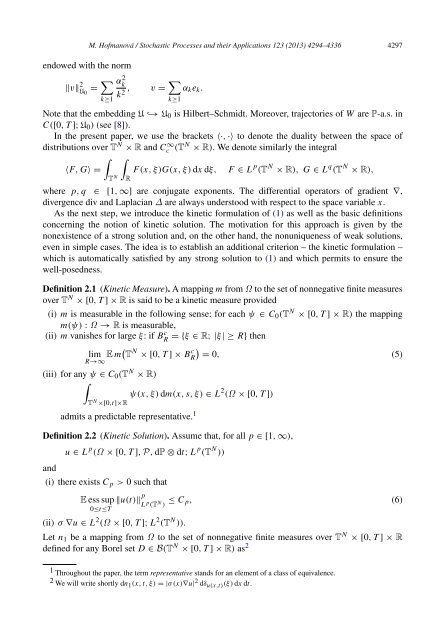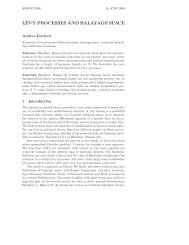Degenerate parabolic stochastic partial differential equations
Degenerate parabolic stochastic partial differential equations
Degenerate parabolic stochastic partial differential equations
Create successful ePaper yourself
Turn your PDF publications into a flip-book with our unique Google optimized e-Paper software.
endowed with the norm<br />
M. Hofmanová / Stochastic Processes and their Applications 123 (2013) 4294–4336 4297<br />
∥v∥ 2 U 0<br />
= k≥1<br />
α 2 k<br />
k 2 ,<br />
v = α k e k .<br />
k≥1<br />
Note that the embedding U ↩→ U 0 is Hilbert–Schmidt. Moreover, trajectories of W are P-a.s. in<br />
C([0, T ]; U 0 ) (see [8]).<br />
In the present paper, we use the brackets ⟨·, ·⟩ to denote the duality between the space of<br />
distributions over T N × R and Cc ∞(TN × R). We denote similarly the integral<br />
⟨F, G⟩ =<br />
T N <br />
R<br />
F(x, ξ)G(x, ξ) dx dξ,<br />
F ∈ L p (T N × R), G ∈ L q (T N × R),<br />
where p, q ∈ [1, ∞] are conjugate exponents. The <strong>differential</strong> operators of gradient ∇,<br />
divergence div and Laplacian ∆ are always understood with respect to the space variable x.<br />
As the next step, we introduce the kinetic formulation of (1) as well as the basic definitions<br />
concerning the notion of kinetic solution. The motivation for this approach is given by the<br />
nonexistence of a strong solution and, on the other hand, the nonuniqueness of weak solutions,<br />
even in simple cases. The idea is to establish an additional criterion – the kinetic formulation –<br />
which is automatically satisfied by any strong solution to (1) and which permits to ensure the<br />
well-posedness.<br />
Definition 2.1 (Kinetic Measure). A mapping m from Ω to the set of nonnegative finite measures<br />
over T N × [0, T ] × R is said to be a kinetic measure provided<br />
(i) m is measurable in the following sense: for each ψ ∈ C 0 (T N × [0, T ] × R) the mapping<br />
m(ψ) : Ω → R is measurable,<br />
(ii) m vanishes for large ξ: if BR c = {ξ ∈ R; |ξ| ≥ R} then<br />
lim E m T N × [0, T ] × B c <br />
R = 0, (5)<br />
R→∞<br />
(iii) for any ψ ∈ C 0 (T N × R)<br />
<br />
ψ(x, ξ) dm(x, s, ξ) ∈ L 2 (Ω × [0, T ])<br />
T N ×[0,t]×R<br />
admits a predictable representative. 1<br />
Definition 2.2 (Kinetic Solution). Assume that, for all p ∈ [1, ∞),<br />
and<br />
u ∈ L p (Ω × [0, T ], P, dP ⊗ dt; L p (T N ))<br />
(i) there exists C p > 0 such that<br />
E ess sup ∥u(t)∥ p L<br />
0≤t≤T<br />
p (T N ) ≤ C p, (6)<br />
(ii) σ ∇u ∈ L 2 (Ω × [0, T ]; L 2 (T N )).<br />
Let n 1 be a mapping from Ω to the set of nonnegative finite measures over T N × [0, T ] × R<br />
defined for any Borel set D ∈ B(T N × [0, T ] × R) as 2<br />
1 Throughout the paper, the term representative stands for an element of a class of equivalence.<br />
2 We will write shortly dn1 (x, t, ξ) = |σ (x)∇u| 2 dδ u(x,t) (ξ) dx dt.



